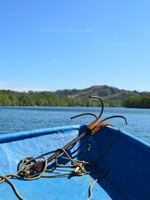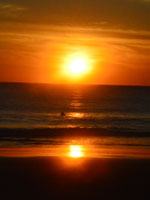

|
Today was a day of education, a day of exploring the natural environment around this corner of Costa Rica. A group of us volunteers took a boat ride up the Tamarindo Estuary, a critical part of the ecosystem here that provides habitat for a rich variety of wildlife. It was just a short drive from the station to the dock along the estuary where we found our captain and tour guide Enrique waiting for us. Enrique, a former poacher, has transformed himself into a conservationist and naturalist. He takes groups of people on his boat up the watery maze of mangrove-laden passageways, where he can unlock some of the secrets of this enigmatic estuary. We boarded the boat, a small flat-bottomed boat that was able to navigate the narrow reaches of the estuary. We started out in wide open waters, near the mouth of the estuary and also near marker #36, our patrolling endpoint at the southern tip of Playa Grande. We got close enough to the ocean that we could hear the breakers, but then we turned back inland so we could take in the full scope of the estuary. The far shore was a popular place for crocodiles to hang out so we headed in that direction. We found one right away, lolling in the shallow waters alongside a beach. I was amazed at how many people were in the water and on the beach, seemingly oblivious to this Crocodylus acutus lurking just a few feet away. We continued up the estuary and began to see a lot of different types of herons, egrets, and ibises. A peaceful ride up the Tamarindo Estuary. As we got further up the estuary, the waterway began to narrow and we found ourselves deep in the mangroves. The intricate root systems of the red and black mangroves lined the shores, revealing the complexity of this unique habitat that balances a wide range of salinity, temperature, and moisture. This is an extremely productive environment, providing food, habitat, and shelter for birds, mammals, and marine organisms. The mangroves provide coastal areas with a buffer against erosion and storm surge, while the massive root systems can dissipate wave energy and slow down tidal water to the degree that sediment is deposited with the incoming tide, leaving all except fine particles when the tide ebbs. Deep into the estuary, Enrique docked the boat and we got out to hike a short trail. Enrique brought us to a place where he was able to call out a group of howler monkeys. The monkeys swung around in the branches of the forest canopy, but they were fairly quiet. Their characteristic spine-chilling cries are usually reserved for early morning or late evening. We watched the monkeys for a while and then hiked back to the dock. The boat trip back was relaxed, with a nice breeze coming up the estuary. Enrique sliced up a couple of fresh pineapples and passed them around, a delicious treat after our explorations. On the way back to the station, we stopped at the beach to excavate a nest at marker #26. It was late afternoon by that time, so very hot on the open beach. The nest had hatched sometime in the past couple of nights, so we wanted to go through it to see if there were any stragglers and also to assess the condition of the eggs. We usually do these excavations in the daytime so we can go through the nest thoroughly and record as much data as possible. Chris dug out the nest while fellow volunteers Laura, Bill, and I helped organize the egg fragments according to their condition. We found one egg that had an almost entire hatchling inside, clutching precariously to what remained of the yolk. A stray dog showed up to watch what we were doing, drawn by the smell of the eggs. Another predator that sea turtles have to deal with in their struggle for survival. Back at the station, we got ready to go down to the beach to watch the sunset. We haven't always had time to do that, but I'm going to try to make it a habit for the last few days that we are here. Playa Grande is a majestic place at any time of day, but at sunset it takes on an aura of pure euphoric bliss. It was a spectacular puesta del sol, with the sun sizzling into the Pacific Ocean in a spectacular burst of color. I didn't go out on the beach that night, because I was assigned to join the Morning Walk the next day. This particular task starts at 5:00 am and involves doing one last sweep of the entire beach, looking for any late turtles and especially looking for nests from which hatchlings have emerged. |
||||
|
||||
|
© 2015 Michael Hanrahan
|